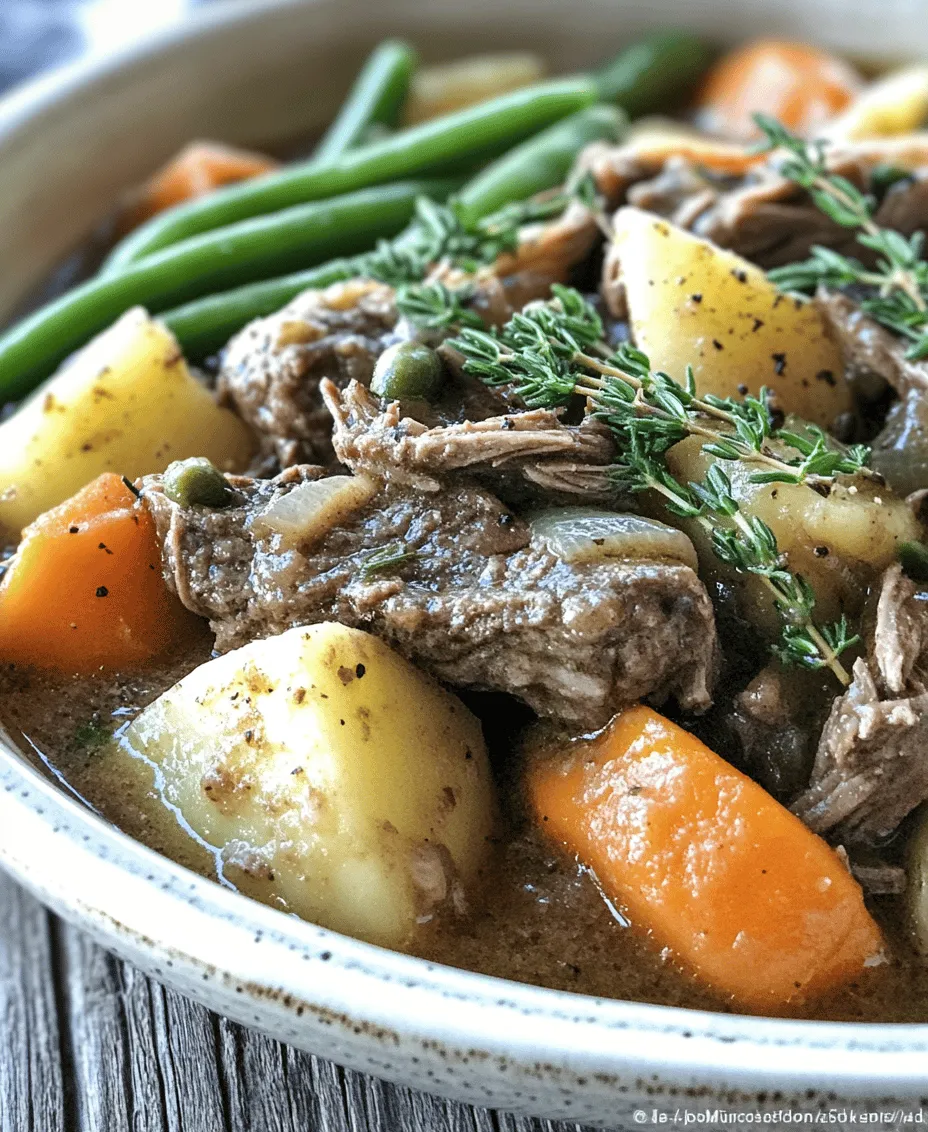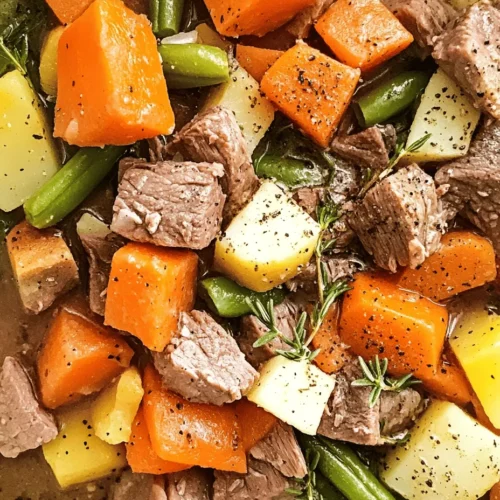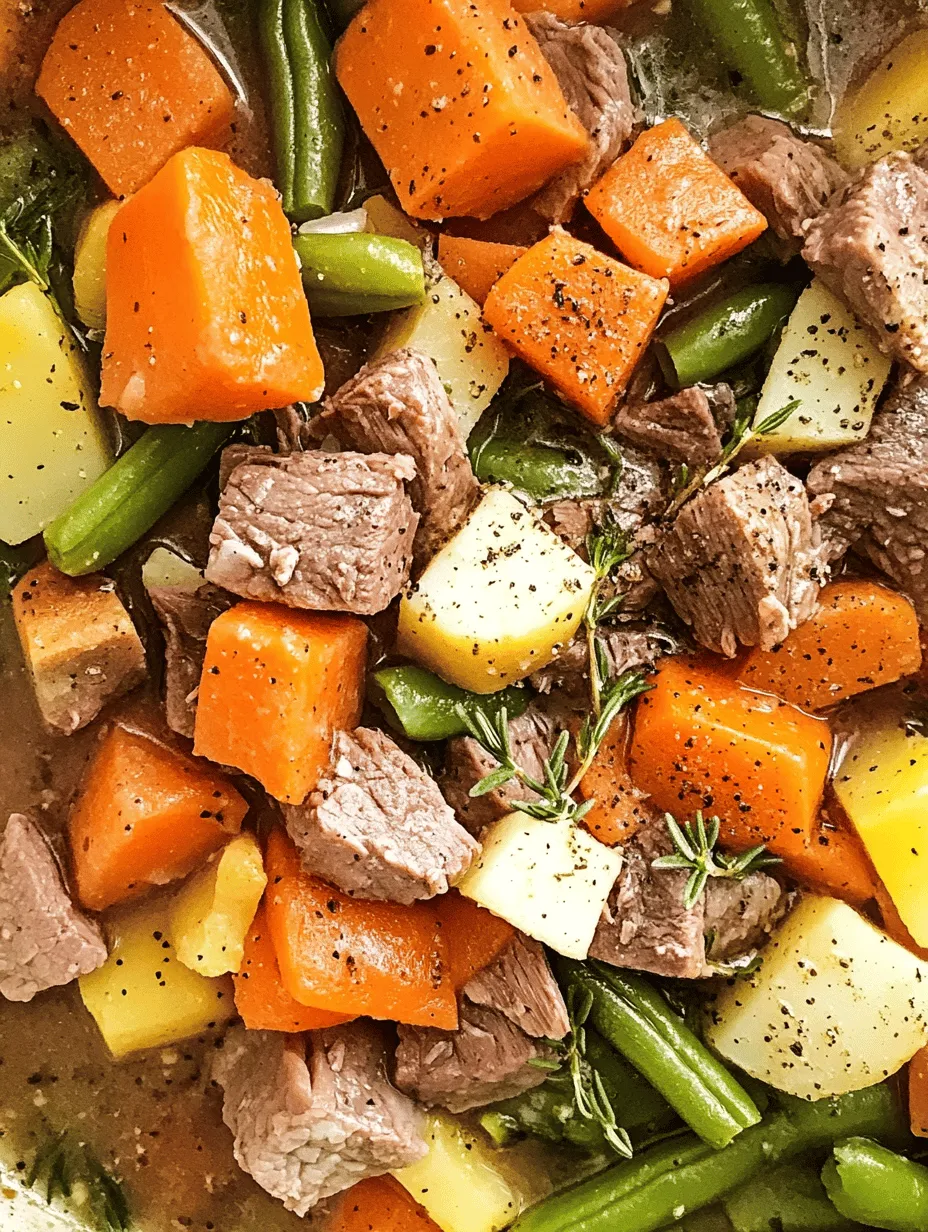Introduction
There’s something undeniably comforting about a steaming bowl of beef stew, especially on chilly evenings or rainy days. This classic dish has been a beloved staple in homes for generations, revered for its ability to warm both body and soul. The rich flavors, tender meat, and hearty vegetables come together to create a meal that feels like a warm hug, making it the ultimate comfort food. Whether you’re gathering with family for a cozy dinner or looking for a nourishing meal prep option that can be enjoyed throughout the week, this Hearty & Comforting Slow Cooker Beef Stew is the perfect choice.
One of the key elements that elevate this stew is the method of slow cooking. Unlike traditional cooking methods that may rush the process, slow cooking allows the flavors to develop and deepen over time. The low, gentle heat transforms tougher cuts of meat into succulent morsels, while the vegetables absorb the savory broth, creating a harmonious blend of tastes and textures. This not only enhances the overall flavor but also ensures that every bite is tender and satisfying.
In this article, we will guide you through the process of making this delicious beef stew, highlighting the essential ingredients and preparation steps. We will also explore the benefits of slow cooking and why this recipe is perfect for any occasion, from weeknight dinners to meal prepping for busy days.
Understanding the Ingredients
Creating a hearty beef stew begins with selecting the right ingredients. Each component plays a crucial role in building the stew’s rich flavor and nutritional profile. Let’s take a closer look at the main ingredients that make this dish exceptional.
Beef Chuck: The Best Cut for Stew
When it comes to beef stew, the cut of meat is critical. Beef chuck is widely regarded as the best choice for stew due to its balance of flavor and tenderness. This cut comes from the shoulder of the cow, which is a well-exercised muscle, making it flavorful yet tough. The beauty of slow cooking is that it breaks down the connective tissues in tougher cuts like chuck, transforming them into melt-in-your-mouth pieces of beef. As it cooks, the fat and collagen in the meat dissolve, enriching the stew with a deep, luscious flavor.
Vegetables: Carrots, Potatoes, Green Beans, and Peas
A well-rounded beef stew is not complete without a medley of vegetables that add both flavor and nutrition. In this recipe, we utilize carrots, potatoes, green beans, and peas, each bringing its own unique qualities:
– Carrots: Sweet and vibrant, carrots not only add a pop of color but also provide essential vitamins and minerals, including beta-carotene and vitamin K.
– Potatoes: These starchy vegetables act as a natural thickener for the stew while offering a comforting texture that complements the meat. They are also a good source of potassium and dietary fiber.
– Green Beans: Adding a slight crunch and fresh flavor, green beans enhance the stew’s overall texture and provide vitamins A, C, and K.
– Peas: These little green gems bring a touch of sweetness and a burst of color, while also contributing protein and fiber to the dish.
Together, these vegetables create a balanced and hearty stew that nourishes the body and satisfies the palate.
Aromatics: The Importance of Onions and Garlic
No stew is complete without aromatics, and in our recipe, onions and garlic take center stage. These ingredients are essential for building a flavorful base:
– Onions: When sautéed, onions develop a sweet and savory flavor that forms the foundation of the stew. They add depth and richness, enhancing the overall taste.
– Garlic: Known for its robust flavor, garlic adds a fragrant aroma and a hint of zest. It complements the beef and vegetables beautifully, elevating the dish to new heights.
These aromatics are what transform a simple stew into a complex and delightful dish.
Herbs and Spices: Thyme, Rosemary, and Bay Leaves
To further enhance the flavor profile of our beef stew, we incorporate a blend of herbs and spices. Thyme, rosemary, and bay leaves each contribute their unique characteristics to the dish:
– Thyme: This herb has a subtle earthy flavor that pairs perfectly with beef. It’s a staple in many stews and soups, providing a warm, aromatic quality.
– Rosemary: With its pine-like scent, rosemary adds a fragrant note that complements the richness of the meat. It’s particularly effective in slow-cooked dishes, where its flavor can meld beautifully with the other ingredients.
– Bay Leaves: Used whole and removed before serving, bay leaves impart a subtle depth of flavor, enhancing the stew’s savory notes.
These herbs create a fragrant backdrop that ties all the flavors together, making each spoonful a delightful experience.
Gluten-Free Options: Including Worcestershire Sauce
For those who are gluten-sensitive or following a gluten-free diet, it’s important to choose ingredients carefully. Worcestershire sauce, a traditional ingredient in beef stew, often contains gluten. However, there are gluten-free alternatives available that can provide the same savory depth without compromising flavor. Look for gluten-free Worcestershire sauce brands or consider using tamari, which is a gluten-free soy sauce, to achieve a similar effect.
Preparation Steps Explained
Now that we’ve covered the essential ingredients, it’s time to prepare our Hearty & Comforting Slow Cooker Beef Stew. Proper preparation is key to ensuring that the flavors meld beautifully and the textures are just right.
Preparing the Beef
The first step in creating a flavorful stew is properly preparing the beef. Here are some essential pointers:
1. Choosing the Right Cut: As mentioned earlier, beef chuck is the best option for stew. Choose a well-marbled piece of meat, as the fat will render down during cooking, adding flavor and moisture.
2. Seasoning the Meat: Before browning the beef, season it generously with salt and pepper. This not only enhances the flavor of the meat but also helps to create a delicious crust when searing.
3. Browning the Beef: In a large skillet, heat a tablespoon of oil over medium-high heat. Once the oil is hot, add the beef in batches to avoid overcrowding the skillet. Browning the meat is crucial, as it develops a rich flavor through the Maillard reaction. Aim for a nice brown crust on all sides.
4. Avoiding Overcrowding: If you add too much beef to the skillet at once, it will steam instead of sear, preventing that deep flavor from developing. Work in batches if necessary to ensure even browning.
Sautéing Aromatics
Once the beef is browned, it’s time to focus on the aromatics:
1. Adding Onions and Garlic: In the same skillet, add chopped onions to the remaining oil. Sauté them over medium heat until they are softened and translucent, about 5 minutes. Avoid browning them too much, as you want to maintain their sweet flavor.
2. Incorporating Garlic: After the onions are softened, add minced garlic and sauté for an additional minute, just until fragrant. Be careful not to burn the garlic, as it can become bitter.
Layering Ingredients
Layering is an essential technique when it comes to slow cooking, ensuring that all ingredients cook evenly and flavors meld beautifully:
1. Layer the Ingredients in the Slow Cooker: Start by placing the browned beef at the bottom of the slow cooker. Follow with the sautéed onions and garlic, then add the vegetables—carrots, potatoes, green beans, and peas.
2. Mixing Liquid Ingredients: In a separate bowl, combine your broth, Worcestershire sauce, and any additional seasonings. Pour this mixture over the layered ingredients in the slow cooker, ensuring that everything is evenly coated.
3. Avoiding Overmixing: While it’s important to ensure that the liquid covers the ingredients, avoid overmixing at this stage. The layering helps to maintain the texture of the vegetables and prevents them from becoming mushy during cooking.
The Slow Cooking Process
With everything layered nicely in the slow cooker, it’s time to set it and let the magic happen. One of the most appealing aspects of slow cooking is the flexibility it offers.
Cooking on Low vs. High
You have the option to cook your beef stew on either the low or high setting:
– Low Setting: Cooking on low for 8 to 10 hours allows for a gradual and even cooking process. This is especially beneficial for tougher cuts of meat, as it gives the collagen ample time to break down and results in a more tender and flavorful stew.
– High Setting: If you’re short on time, you can cook on high for about 4 to 6 hours. While this will still yield a delicious stew, the flavors may not be as deeply developed as when cooked on low.
Benefits of Slow Cooking Over Traditional Methods
Slow cooking offers several advantages over traditional methods. The extended cooking time allows for the flavors to meld together beautifully, creating a stew that is rich and satisfying. Additionally, slow cooking is more forgiving—there’s less risk of overcooking the meat or vegetables, making it an ideal method for busy cooks.
The Role of Time in Flavor Development
Time is truly the secret ingredient in slow cooking. As the stew simmers away, the flavors continue to develop and intensify. The longer cooking time allows the beef to become tender and juicy while the vegetables soften and absorb the savory broth. This slow melding of flavors is what makes slow cooker beef stew such a beloved dish, perfect for sharing at family gatherings or enjoying on a quiet night in.
As we move forward in this recipe, we will delve deeper into the nuances of seasoning, serving suggestions, and tips for the best results. But for now, you’re well on your way to preparing a comforting and hearty beef stew that will delight your taste buds and warm your heart.

The Impact of Adding Vegetables at Different Stages of Cooking
When preparing a slow cooker beef stew, the timing of vegetable additions plays a crucial role in achieving the perfect texture and flavor. Different vegetables require varying cooking times, which means that adding them at the right moment can significantly enhance the dish.
For instance, root vegetables like carrots and potatoes benefit from the long cooking time and should be added at the beginning. They become tender and absorb the flavors of the beef and broth, contributing to the overall depth of the stew. On the other hand, more delicate vegetables, such as peas or bell peppers, should be added towards the end of the cooking process. This ensures they retain some crunch and freshness, adding a delightful contrast to the tender beef and starchy vegetables.
Finishing Touches
Adding Peas and Final Seasoning
As the stew approaches its final hour of cooking, it’s time to incorporate the peas. Not only do they add a pop of color, but they also bring a subtle sweetness that complements the savory flavors of the stew. The key to getting the best results is timing. Add the peas about 30 minutes before serving to ensure they are cooked through but still vibrant and slightly firm.
Final seasoning is equally important. Taste the stew just before serving and adjust the seasoning if necessary. You may find that a pinch of salt or a dash of pepper elevates the flavors. If you’re looking to enhance the taste further, consider adding a splash of Worcestershire sauce or a hint of fresh herbs like parsley or thyme just before serving.
Serving Suggestions
To elevate your beef stew experience, consider these serving suggestions:
1. Accompaniments: Serve your hearty beef stew with crusty gluten-free bread or a warm biscuit to soak up the delicious broth. A simple side salad with mixed greens and a light vinaigrette can also balance the richness of the stew.
2. Presentation Tips: For an appealing presentation, ladle the stew into deep bowls and garnish with freshly chopped herbs. A sprinkle of black pepper or a drizzle of balsamic reduction can add elegance to the dish. Consider using rustic bowls or plates to enhance the cozy, comforting vibe of the meal.
Nutritional Information
Understanding the nutritional content of your homemade beef stew can help you appreciate its health benefits. Here’s a breakdown of what you can expect per serving:
– Calories: Approximately 400-500 calories, depending on the amount of beef and vegetables used.
– Protein: Around 30 grams, thanks to the lean cuts of beef, providing essential amino acids for muscle repair and overall health.
– Carbohydrates: Roughly 40 grams, primarily from the vegetables and any added starches, offering a good source of energy.
– Fats: Approximately 15 grams, mainly from the beef, which can be reduced by using lean cuts.
Key ingredients like carrots, potatoes, and peas not only add flavor but also provide fiber, vitamins, and minerals. Incorporating fresh vegetables ensures that the stew is nutrient-dense, promoting digestive health and overall well-being.
Variations and Customizations
One of the great things about beef stew is its versatility. Here are some variations and customizations to suit different dietary needs or to keep the recipe fresh:
Alternative Ingredients for Different Dietary Needs
– Cuts of Meat: While chuck roast is typically used, you can experiment with other cuts like brisket or sirloin. For a leaner option, consider using ground beef or even turkey.
– Plant-Based Options: For a vegetarian or vegan alternative, substitute the beef with hearty vegetables like mushrooms or use plant-based protein such as lentils or chickpeas. Adjust cooking times accordingly.
Seasonal Vegetable Swaps
Incorporate seasonal vegetables to keep the stew interesting. In the fall and winter, root vegetables like parsnips and turnips work beautifully, while spring and summer allow for the addition of zucchini, green beans, or corn.
Flavor Enhancements
To give your beef stew a unique twist, consider adding red wine to the broth for depth and richness. Alternatively, different herbs like rosemary or bay leaves can add complexity to the flavor profile. Don’t be afraid to experiment with spices like smoked paprika or cumin for an unexpected kick.
Storing and Reheating Leftovers
Proper storage of your beef stew will ensure its longevity and flavor retention. Here are some best practices:
– Refrigeration: Allow the stew to cool completely before transferring it to an airtight container. It can be stored in the refrigerator for up to 3-4 days.
– Freezing: If you want to extend the shelf life, beef stew freezes well. Portion it into freezer-safe containers, leaving some space for expansion. It can last up to 3 months in the freezer.
When it comes to reheating, the stovetop is preferred. Heat gently over medium-low heat, stirring occasionally to prevent sticking. Add a splash of broth or water if the stew appears too thick. The flavors of the stew often deepen after resting, making leftovers a delightful option.
Conclusion
A hearty and comforting slow cooker beef stew is more than just a meal; it’s a warm embrace on a chilly day, a reminder of family gatherings, and a dish that nourishes both body and soul. The ease of preparation in a slow cooker allows you to enjoy the rich flavors without spending hours in the kitchen.
We encourage you to explore this recipe and make it your family favorite, adapting it to suit your tastes and dietary needs. The joy of cooking and sharing meals with loved ones is a cherished experience, and nothing brings people together quite like a bowl of homemade beef stew. So gather your ingredients, set your slow cooker, and enjoy the process of creating a comforting dish that everyone will love.


